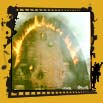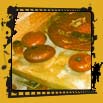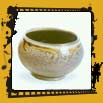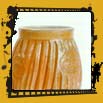 Heritage Community Foundation Presents
Heritage Community Foundation PresentsAlberta Online Encyclopedia
 |
 |
 |
|||
     |
Legacy Article "Flame Throwers" I'm holding a bowl, a handmade pottery bowl that's been touched by the fire. A ritual baptism, this encounter with the flame has carried the bowl from one world to the next, anointing its rim and softly sloping interior with ash melted to an almost translucent green. Outside, one side blushes, remembering the flame's fiery kiss. For clay to become pottery, it must pass through a series of transformations, a series of tests. For its final test, it must pass through fire. The history of using wood to make that fire stretches back thousands of years. During a wood firing, ash floats through the kiln, landing on the exposed parts of the pots, finally melting into a glaze with lustrous depth. In Alberta, many potters are choosing to fire with wood to have a chance to dance with the flame. John Chalke, one of Alberta's premier potters, has been building wood fire kilns and inviting the flame to dance for over 30 years. He thinks of his kiln just outside Calgary as being part of the landscape, part of the whole organic experience of forming clay into objects and transforming them with fire. Christian Barr and Enzien Kufeld are two potters living near Wildwood, Alberta. They have built three wood fire kilns. For Barr, wood firing is a spiritual process, and the kiln has a central role. "I build kilns and kiln sheds with the idea that they are ritual spaces," he says, "Places that celebrate our unity of body, mind, and spirit. These kilns belong to their place as though they have always been." For potter Tammy Parks-Legge, watching the kiln during a firing is totally enthralling. "The flames shoot out the chimney and the blowhole on the door of my kiln," she says, "I never get tired of the process."
During a wood firing, the kiln must be attended regularly. Wood firings last hours, more usually days. The kiln is warmed gradually, then the fire is built steadily, coaxed stick by stick and slab by slab to reach out through the kiln's chamber. During loading, temperature indicators called cones are placed throughout the kiln. Each cone is made to slump over at a certain temperature, showing the potter how hot the kiln is getting, how fast things are moving. Welder's glasses shield human eyes from the searing flames. The pots have no protection. Some flinch and crack as the flame comes near. Others are open to it, waiting for transfiguration.
"It's exhausting and rewarding at the same time," Enzien Kufeld says. "You can try to manipulate the flame on the piece and also even get an understanding of what may happen with the flame, but you never know for sure." Tom McFall, executive director of the Alberta Craft Council, agrees. The Craft Council recently mounted a show featuring the wood fired work of 21 Alberta potters. McFall describes wood firing as the "extreme version" of working with clay because of the risks involved, and the energy the potter has to put into it. "The technical difficulties are magnified over gas or electric firing," he says emphatically. "The length of the firing, the personalities of the custom built kilns (many potters build their own), and the role of chance all magnify the risks. There's a fine line between magnificence and disaster."
The relationship between the kiln and the potter, the give and take that has the potential to produce exceptional, ethereal work, characterizes the working lives of the established and emerging wood firing potters in Alberta, and their relationships with each other. They share techniques and glaze recipes. They fire together, sweating to feed the kiln, then musing over the results, trying to capture with words and understanding outside the kiln what has gone on inside it. "Firing with wood is a chance to collect people around you to share your kiln," says Chaike, "to share the experience of creating." The sense of community is strong here. "I would not stop wood firing if there was no community around us," says Kufeld. "But," she continues, "it would not be as rewarding."
Patricia Myers is a freelance writer and student of pottery in Edmonton. |
|
|||
|
|
|||||
|
Copyright © 2003 Heritage Community Foundation All Rights Reserved |
|||||
 |
 |
 |
For more on Alberta's Arts Heritage, visit Peel’s Prairie Provinces.









